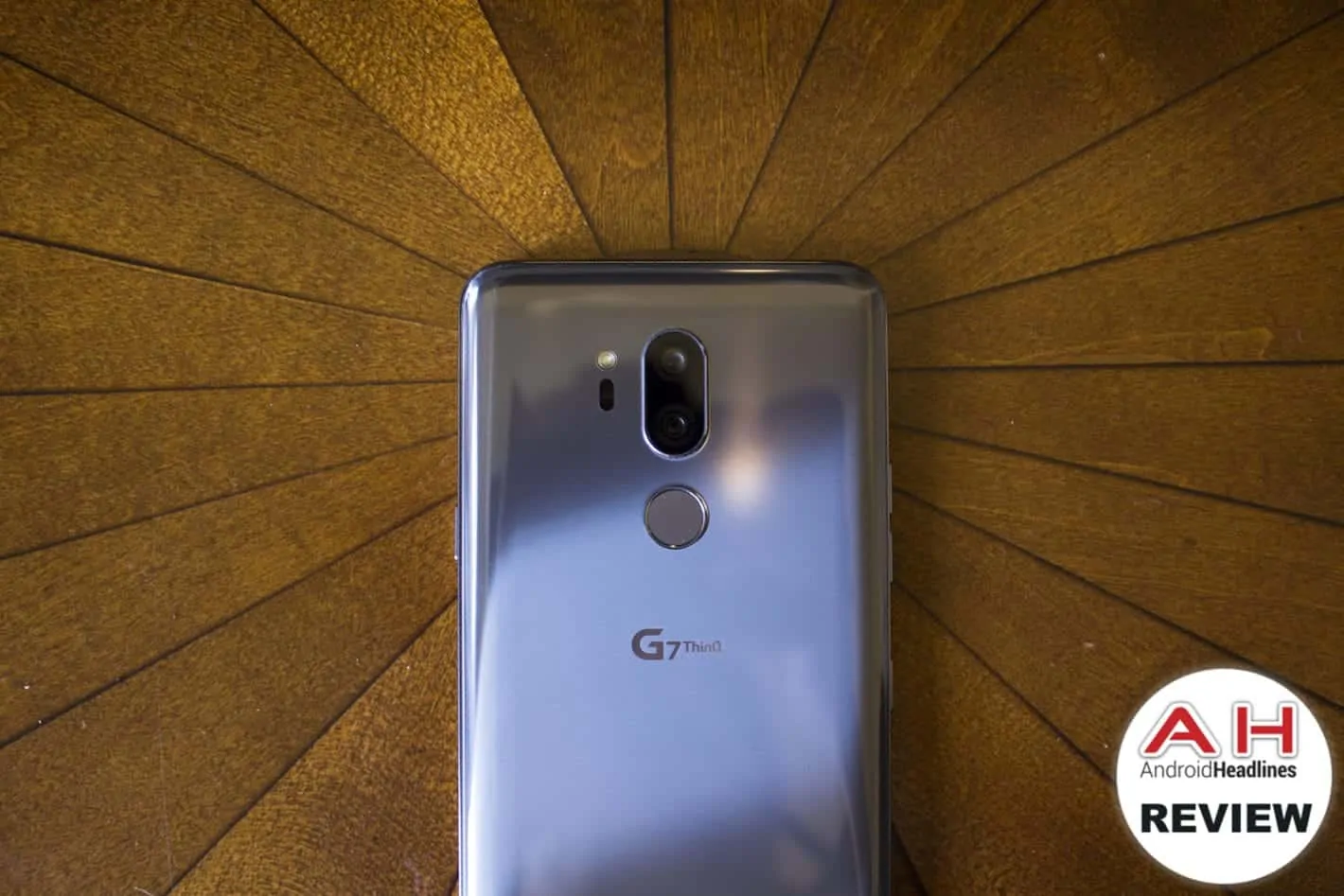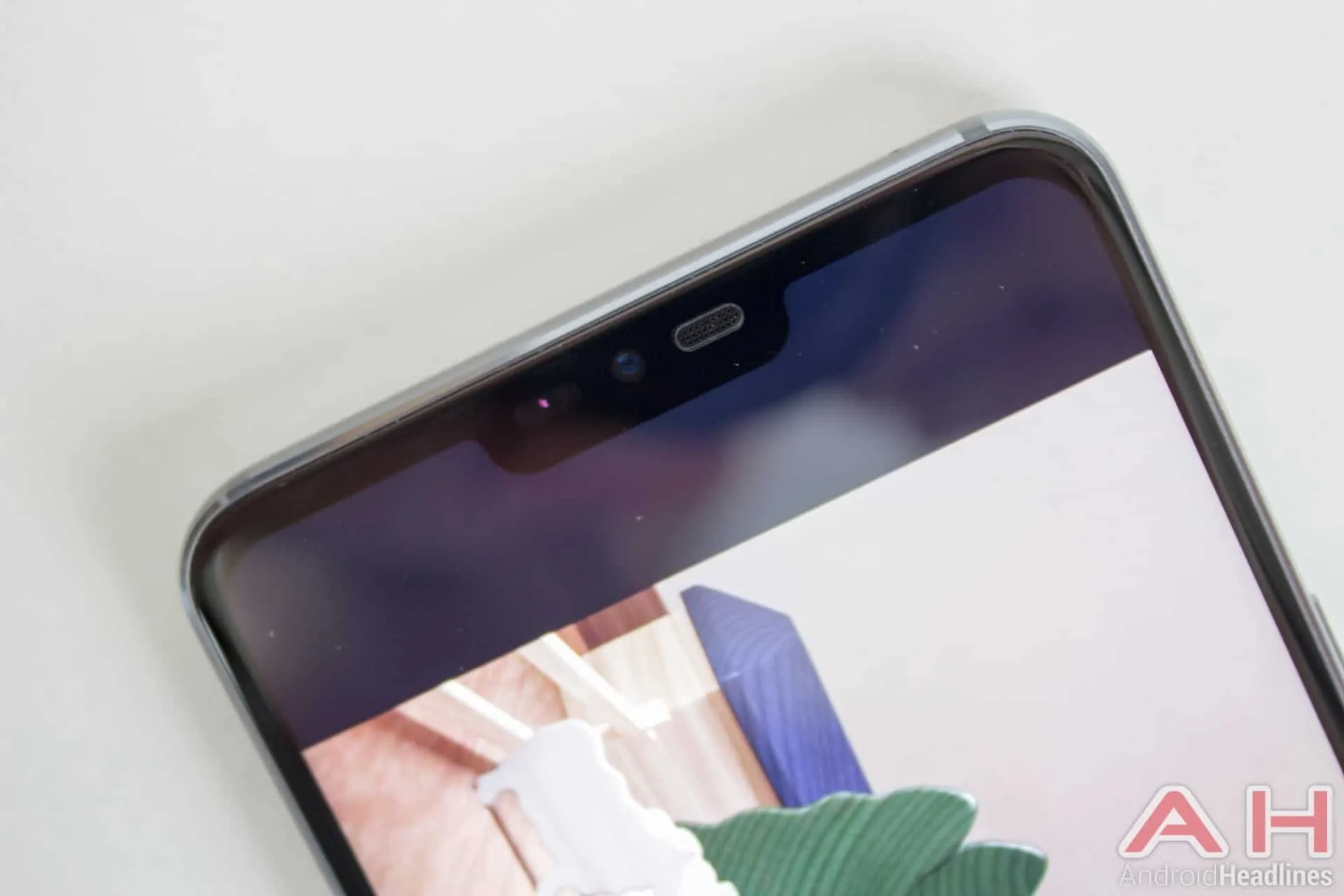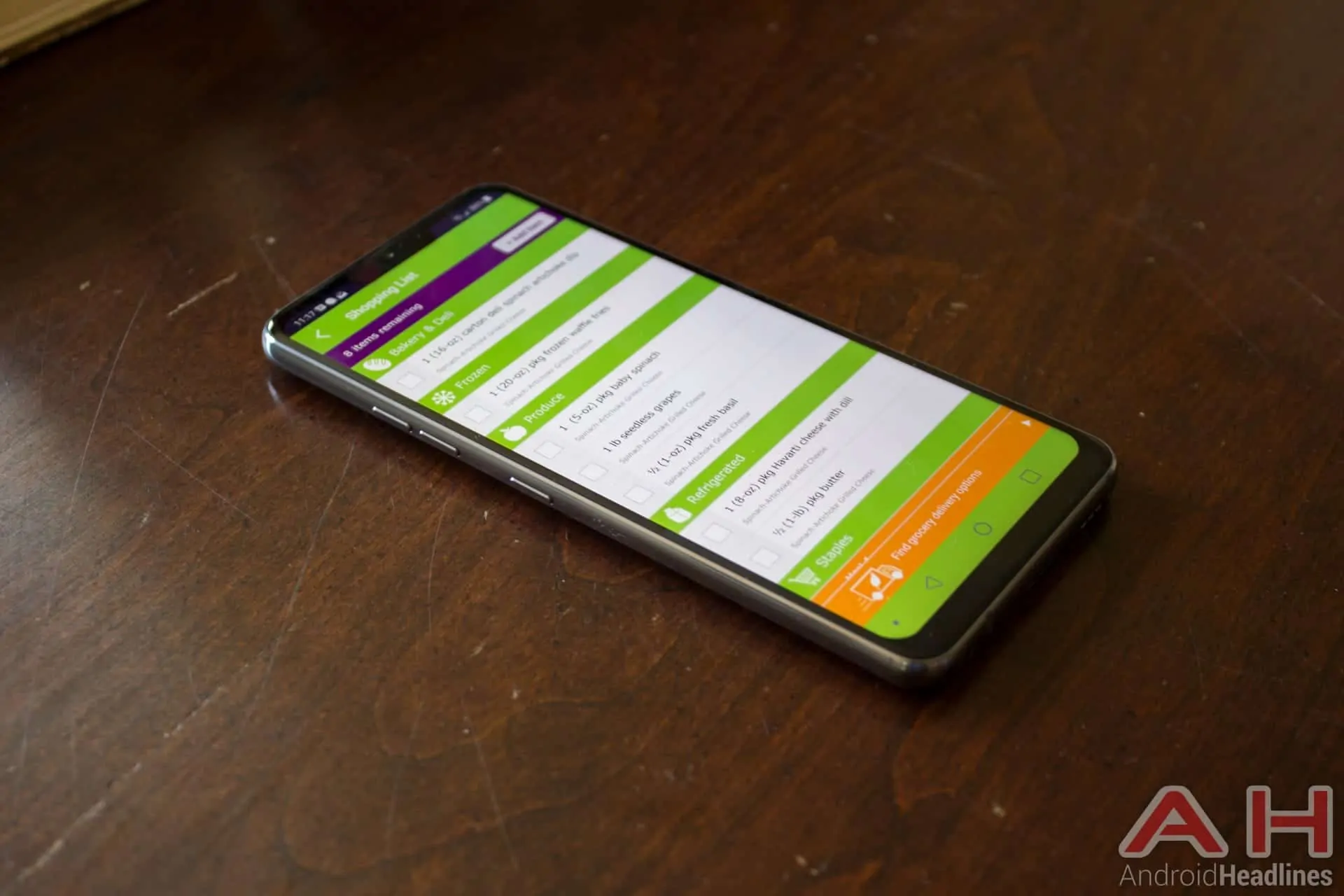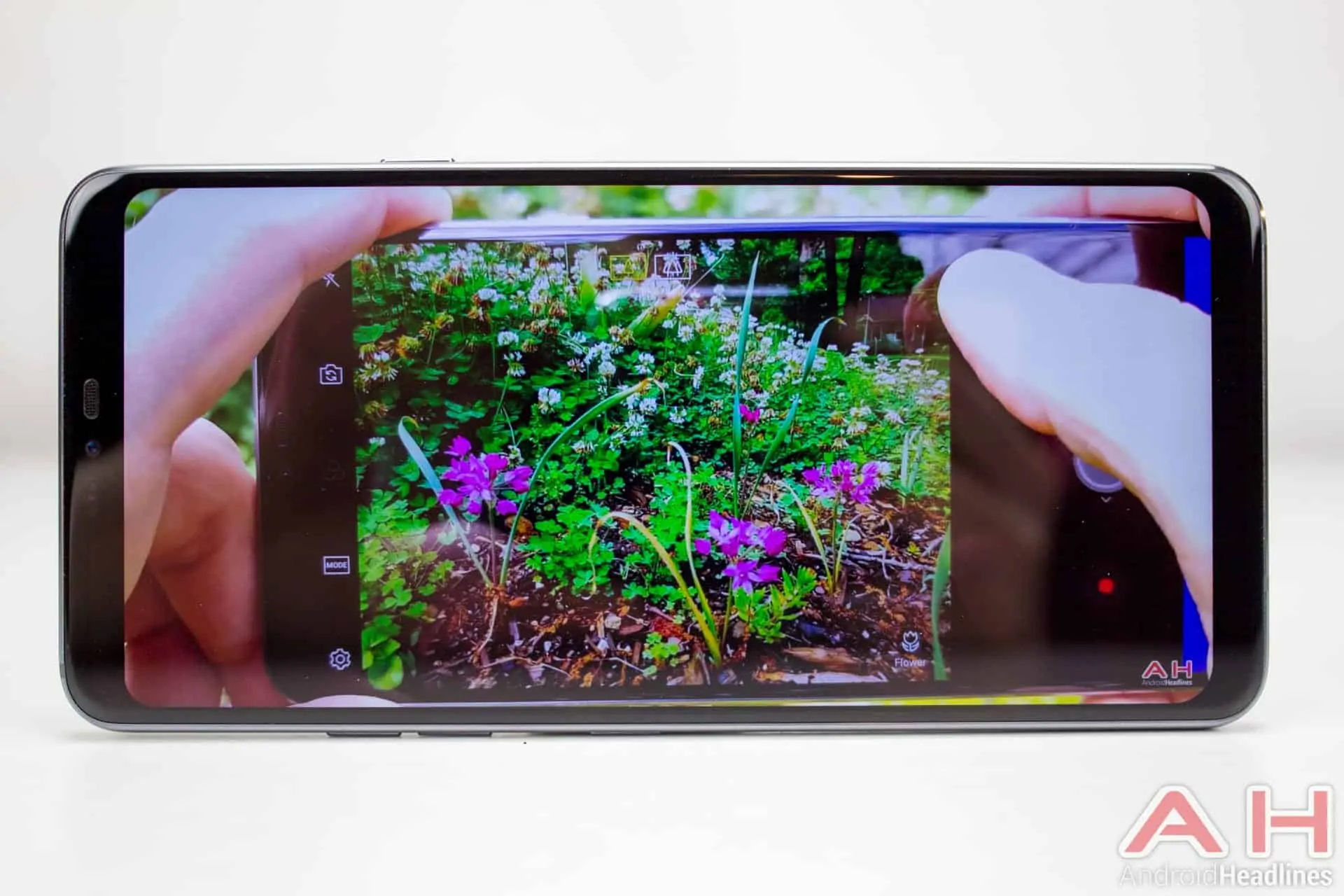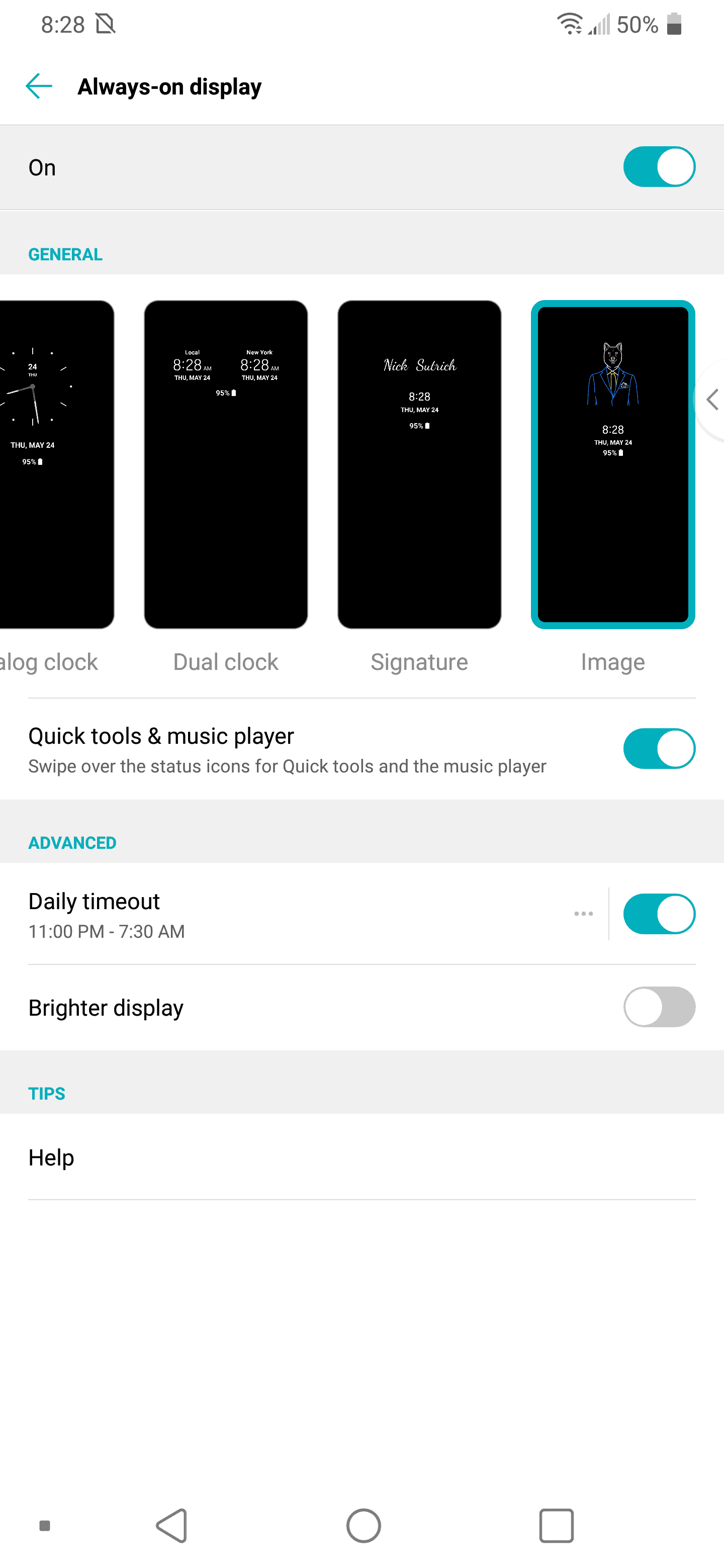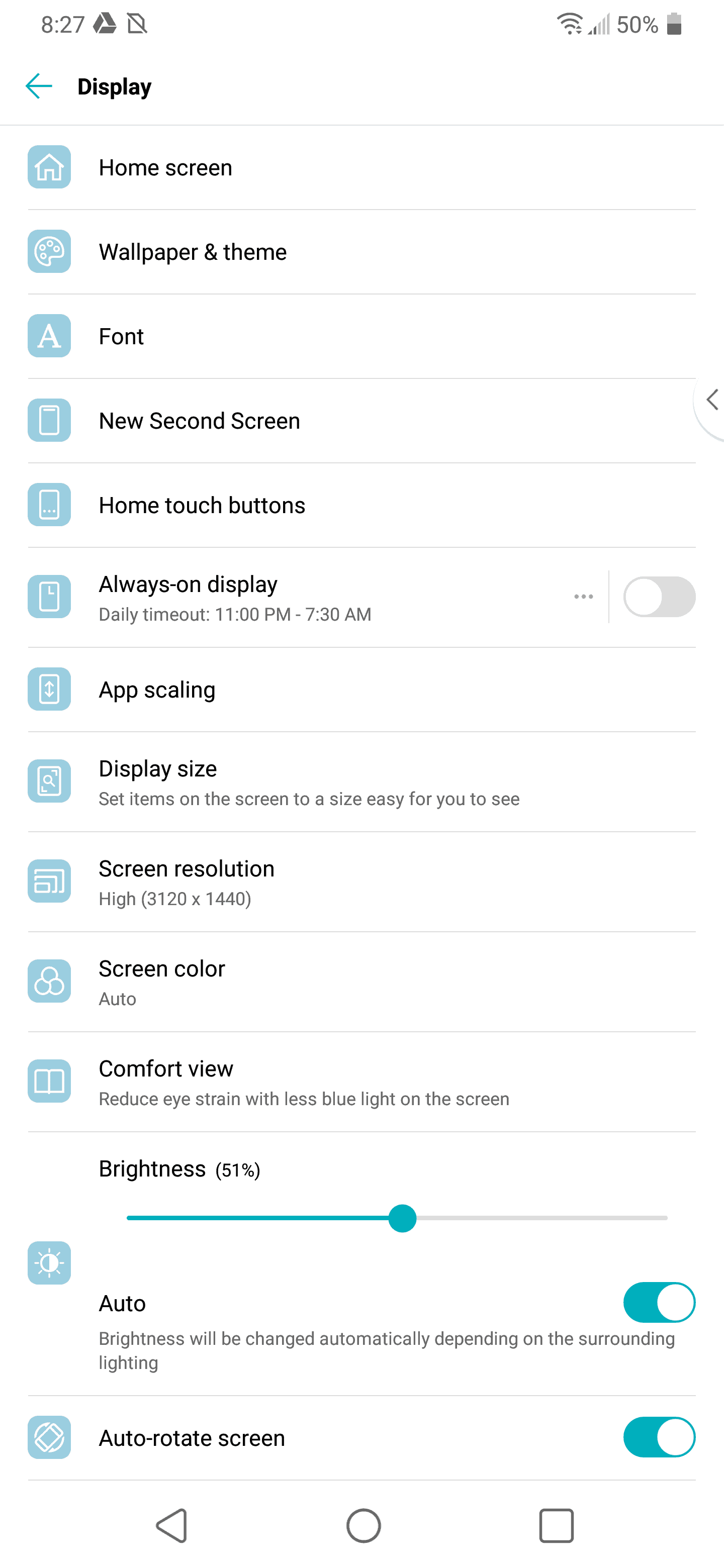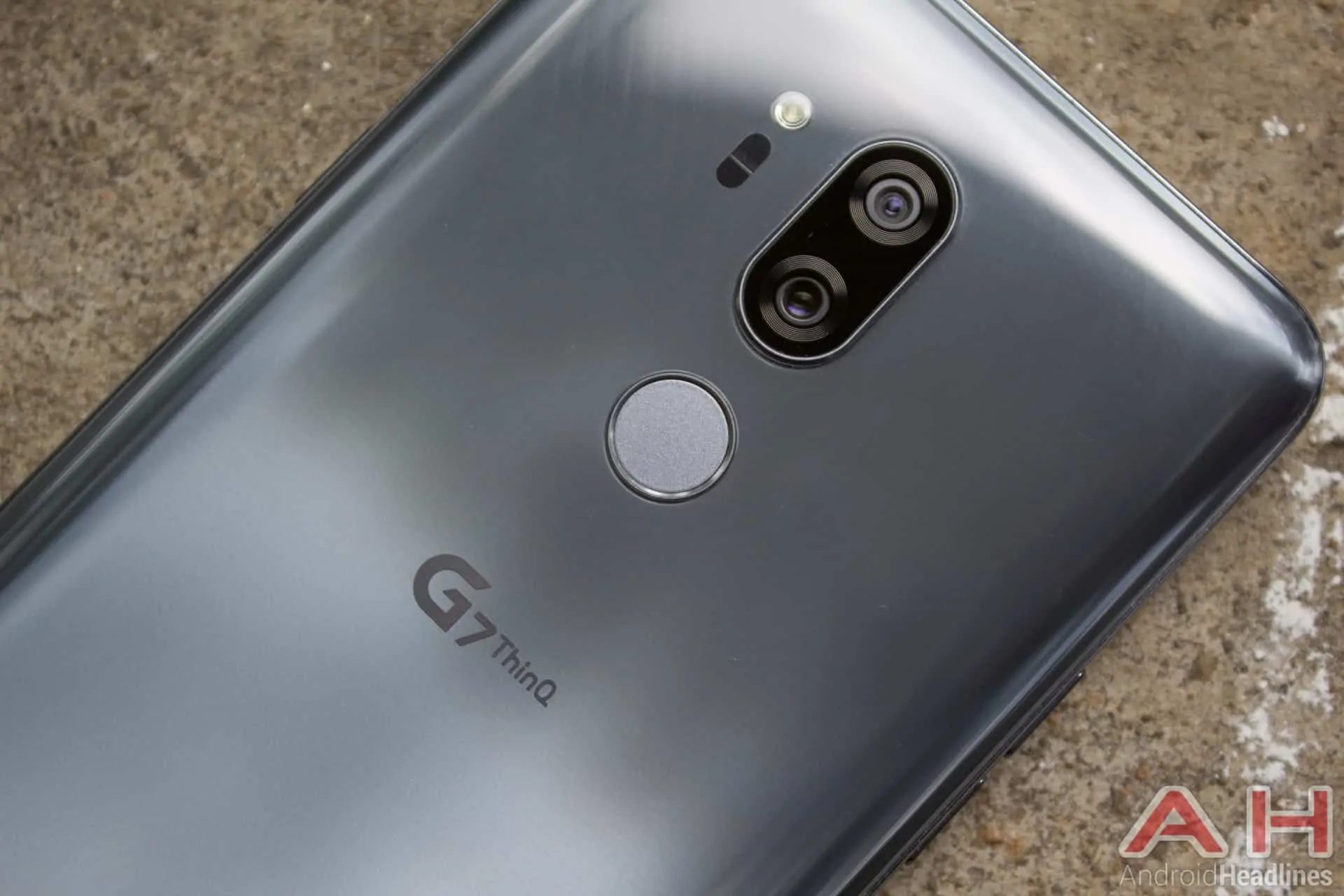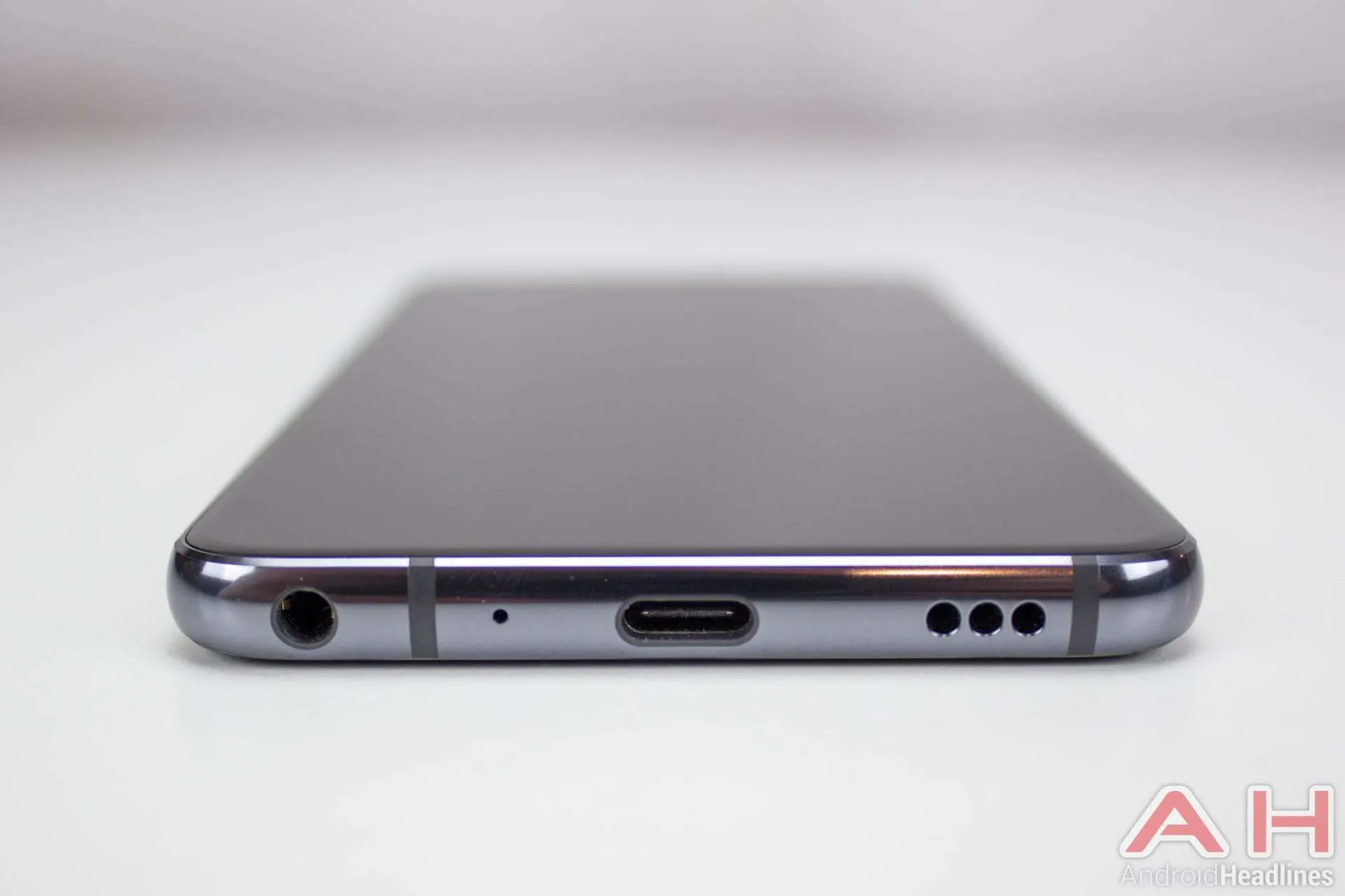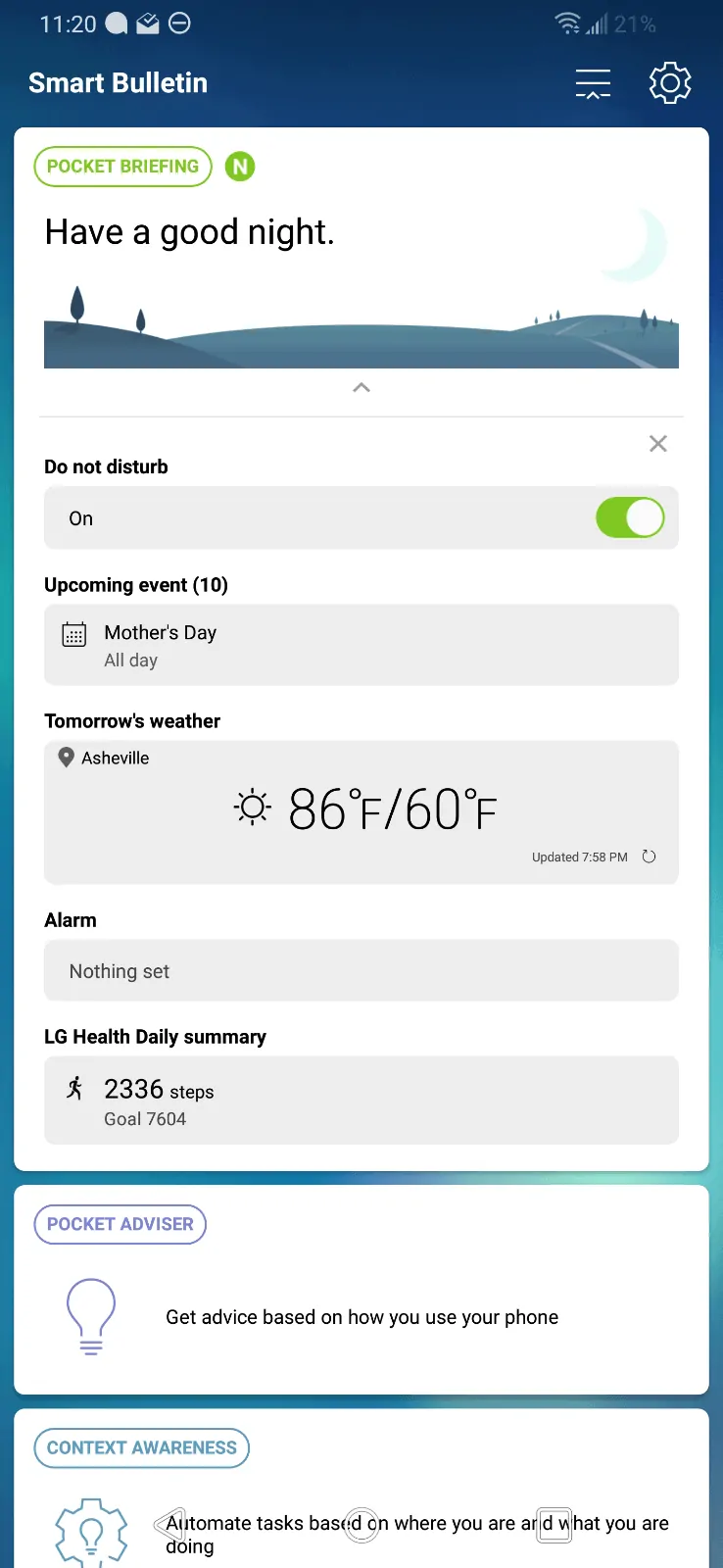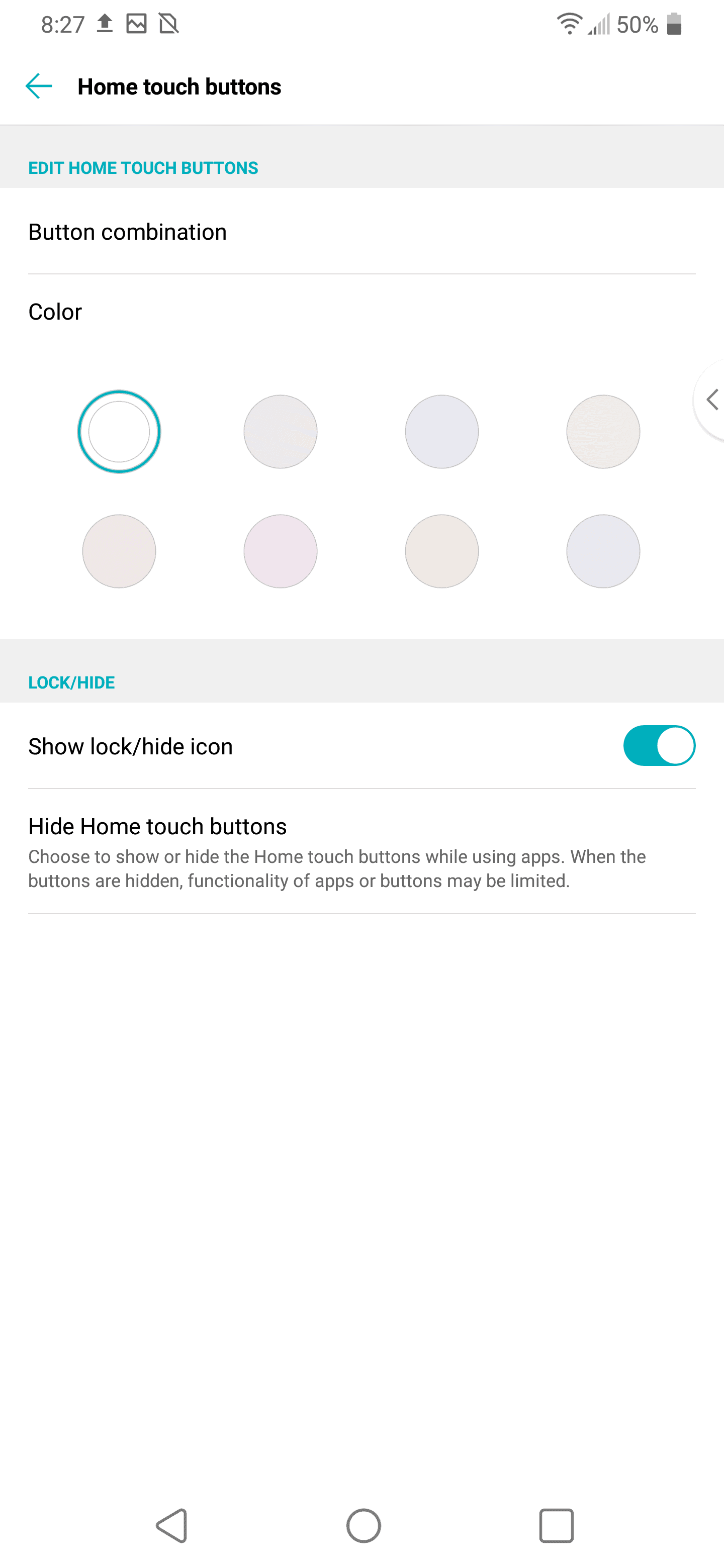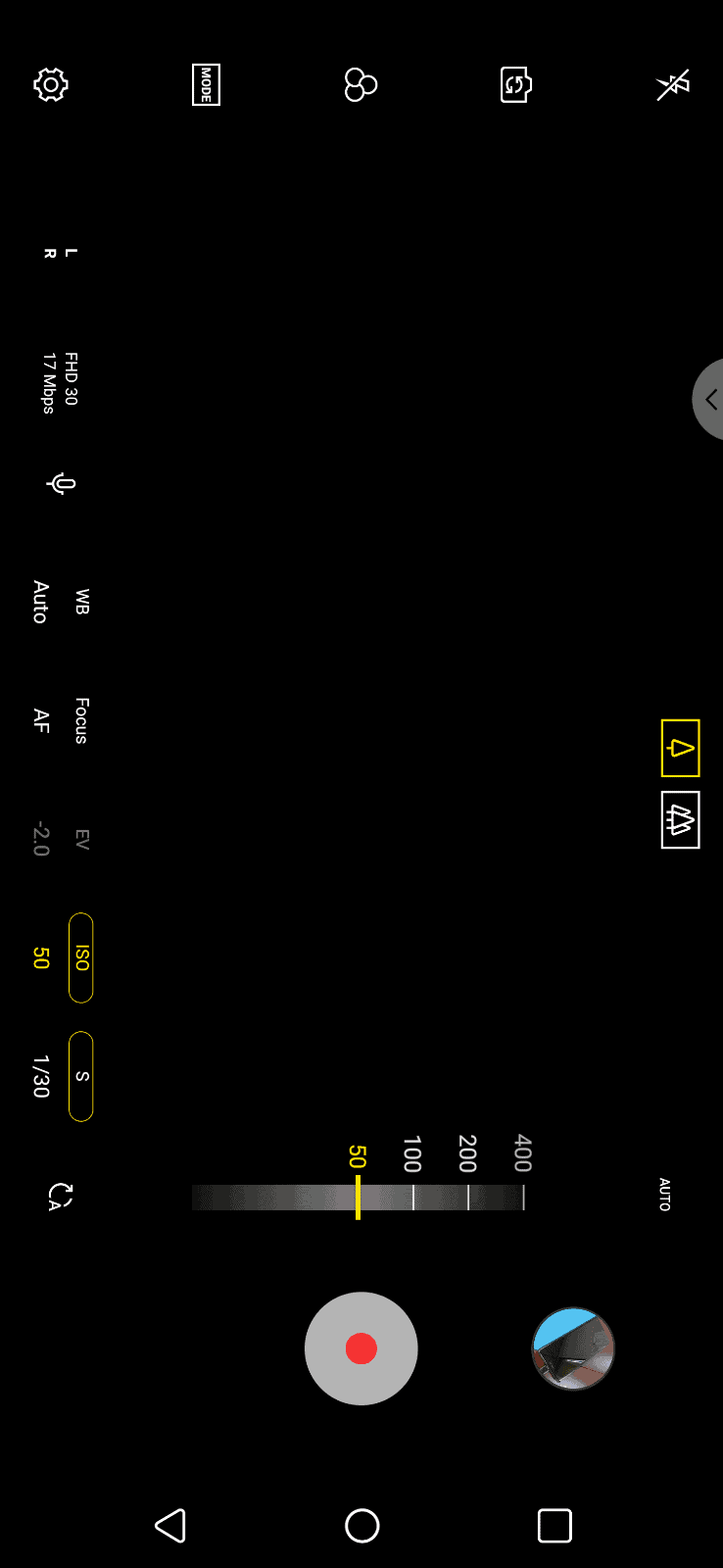Gorgeous new colors, Boombox speaker, and an ultra-bright display
2018 is ushering in a rebranding of LG’s mobile devices, with the LG G7 ThinQ taking on the same naming moniker as the recently launched V30S ThinQ. With this new name comes an updated design, souped-up specs, and a camera experience that promises to be something special. Let’s take a look at LG’s latest offering and see if it unseats the V30’s position as best phone LG has ever made.
Video Review
Specs and What’s in the Box

LG has been a bit coy about pricing for the LG G7 ThinQ, leaving that up to the carriers in the US. European pricing generally hovers around the €850 mark, although some carriers offer discounts when signing up for a plan. LG manufactures the G7 ThinQ in quite a few glamorous colors, not all of which will be available in all regions. Colors include Aurora Black, Platinum Grey, Moroccan Blue, Moroccan Blue (Matte), and Raspberry Rose. On the front sits a 6.1-inch 19.5:9 Quad-HD+ (3120 x 1440 pixels) FullVision IPS LCD display, with a sizable notch cut into the middle of the top. This display is an M+ LCD, which features an RGBW striping configuration for brighter output up to 1,000 nits, and supports HDR10 as well.
Under the hood is a Qualcomm Snapdragon 845 SoC clocked at 2.8GHz, with Adreno 540 GPU and a 3,000mAh battery. QuickCharge 3.0 and wireless PMA/Qi charging are available thanks to the glass back, and LG sells the G7 ThinQ in two configurations: 4GB of LPDDR4X RAM and 64GB of internal storage, or 6GB of LPDDR4X RAM and 128GB of internal storage. All models of the G7 ThinQ feature a Gorilla Glass 5 front and back, aluminum sides, and an IP67 water and dust resistance rating. A 3.5mm audio jack and a USB Type-C port round out the available ports, and 2 mics provide active noise cancellation for videos and calls. A single bottom firing speaker feeds back into the chassis to provide what LG calls Boombox sound, and LG supports DTS:X 7.1 virtual surround sound through the quad-DAC on the 3.5mm jack.
Bluetooth 5.0 provides longer range and bandwidth over previous generations of Bluetooth, and NFC is included for mobile payments and local communication between devices. Dual-band 802.11ac WiFi is included as well. On the front sits an 8-megapixel camera with f/1.9 107-degree angle lens, and on the back you’ll find identical 16-megapixel Sony IMX 351 sensors with f/1.6 71-degree angle lens, and the other behind an f/1.9 110-degree angle lens. Android 8.0 Oreo is pre-installed with LG’s skin running atop, and the phones measures in at 153.2mm high, 71.9mm wide, 7.9mm thin and weighs 162 grams.
LG doesn’t pack a lot inside the box alongside the phone, just the typical set of manuals and warranty pamphlets, as well as a SIM tray ejector tool. A USB Type-A to USB Type-C cord is included, and a Qualcomm QuickCharge 3.0-rated charger with 9v/1.8a output rating is in there too. Recently, LG has been including microfiber cloths with their branding on it in the box, giving you an easy to to keep this all-glass phone shiny and fingerprint-free throughout the day. Some OEMs include clear TPU cases or earbud-style headphones, but LG doesn’t with the unit we received for review, although it’s possible some B&O Play-branded versions might ship with headphones, as some previous B&O branded LG phones offered.
Display

While LG’s OLED manufacturing division has been growing considerably over the past few years, LG is using its OLED displays to differentiate between its most premium high-end products and everything else below that. As such the LG G7 ThinQ has apparently been relegated to not quite the highest-end status, and has instead been graced with the best LCD the company makes right now, the IPS M+ LCD. LG cites that this display gives users what they want most in a mobile display; one that’s incredibly bright outdoors no matter how bright the sunlight gets. At a rated 1,000 nits of brightness, the 6.1-inch display on the G7 ThinQ is among the absolute brightest displays in the mobile world, and can sustain this brightness for up to 3 minutes at a time before toning it down a bit, with LG citing both battery life and overheating issues appearing if this lasts longer.
There’s definitely something to be said about a super bright display on a mobile device. Many OLED displays on mobile phones don’t get bright enough to be truly easy to see outdoors, and while there are certainly some OLEDs that can get this bright, most don’t. Couple this with the coating LG puts on the display to help reduce glare and you’re left with one of the absolute easiest phones to see in the sunlight, if not the absolute easiest. There’s no straining of eyes or covering the phone with your hand, even in direct rays, and it’s really quite nice to have such a feature. LG achieves this by creating a white pixel alongside the traditional red, green and blue pixels in an RGBW stripe configuration. At quad-HD resolution, this means you’ve got tons of white pixels that effectively make the display look “brighter” on the eyes than a traditional RGB stripe would, effectively raising the brightness level without increasing power consumption.
This, in turn, affects the black levels of the display, which are pretty bad even by LCD standards. Black elements of the screen are a very obvious shade of gray, and with the black notch taken out of the top of the display, makes the grey backgrounds even more obvious than usual on an LCD. On the bright side, no pun intended, the viewing angles of this display are absolutely stellar, with almost no visible dimming at any angle, and zero color shift as well. LG’s fusion of display and digitizer make it look like it’s floating on top of the device when viewed from an angle, and while black levels are worse at these angles, makes the display look really crisp and clean while sitting on a table. Motion resolution and pixel persistence are also excellent here, unlike many mobile LCDs, and features no obvious trailing or ghosting during movement. HDR is also properly implemented, meaning all the needed security back-end stuff has been done correctly, so you can enjoy HDR programming in YouTube, Netflix and other apps that support it.
LG’s decision to go with a notch at the top of the display is predictable at this point in 2018, where OEMs are constantly trying to eliminate bezels but have yet to come up with a truly good way to place the camera and other sensors somewhere on the body. The result is a nearly 1-inch wide notch at the top of the screen that contains the front-facing camera, proximity sensor and earpiece speaker. To the left and right of this are all screen and some very tiny bezels, ones that are almost uniformly shaped across the device. There’s some very obvious haloing that occurs around this notch, thanks to LCD being used as a display instead of OLED, as the backlight has to curve around this bezel. The obvious larger bezel is the bottom one, which is the same height of the notch that’s located at the top of the phone.

The parts of the display that flank the left and right sides of the notch are called a “second screen” by LG, a misnomer in any case, as the portion up here acts no different than the status bar on any Android phone in the world. This isn’t like the brilliant second screen designs from the LG V10 or V20, where you could receive detailed notifications and add quick shortcuts, among a host of other options. Rather it’s just a status bar cut in two, rendered less useful because of the notch. LG offers ways to “hide” the notch, but unlike Huawei’s recently released P20 and P20 Pro, these options only function in LG apps.
While there are a handful of cool looking colors and patterns available to choose from, they are marred by the inability to use the function on all apps. All non-LG apps color the status bar to the primary color of the app that’s active, as it does on other Android phones. The inability to truly hide the notch in all apps will likely annoy some folks, as its presence is extremely obvious on any app which doesn’t use a black status bar up top.
LG offers an always-on-display option, which keeps the display on all the time at a low-level brightness, displaying only pertinent information like the time, date, calendar events and notifications as they come in. The idea here is to keep your display from turning on and displaying at a brighter level, however with the inclusion of an LCD panel instead of an OLED one, the purpose of always-on-display is essentially reduced to nothing because of the tech replacement. LG’s always-on-display (AoD) options sit between Samsung’s highly customizable efforts and Huawei’s super-basic AoD display and offers quite a few ways to display a picture, text and other information, as well as customizable bits too.
Hardware and Build

LG’s hardware has improved drastically since the release of the G6, which was LG’s first big glass-and-metal phone with an IP rating for water and dust resistance. The V30 ushered in a whole new look for LG that was considerably more svelte than the somewhat chunky looking G6, and now the G7 ThinQ furthers what LG achieved with the V30, especially when considering the colors offered at launch. LG’s Moroccan Blue and Raspberry Rose offer colors that are often not seen on smartphones, much less in these dramatic hues, while the black and grey variants offer a more subdued set of tones while still feeling new and fresh, thanks to the extra layers of sheen. The front of these devices are completely flat, while the back is mostly flat with slight curves upwards on the sides of the glass.
LG has kept the interesting corner and edge angles that it started with the G5, as the top and bottom are rounded half-moon shapes, while the left and right sides feature a more interesting tapered D-shape to them. This shape makes it easier to pick up from a flat surface, giving an extra touch point for gripping the left and right sides, but doesn’t help make the device any grippier while holding it. In fact, this is one incredibly slippery device that has nearly slipped out of my hand more than once, and actually ended up bouncing across the room, landing onto one of its corners on a hardwood floor from table height. No scratches or dings occured from this fall, but the soft nature of Gorilla Glass 5 rears its ugly head once again, with lots of hairline scratches on the front glass of the device happening during our review period (as it does with essentially all Gorilla Glass 5 covered phones).
One of the best changes LG made, coming from the LG V30, is a device that’s the same height as the V30, features a 0.1-inch larger screen (albeit with a notch), and yet is nearly 4mm more narrow than the V30. It’s ever-so-slightly heavier at 162g versus the V30’s 158g, and slightly thicker as well, measuring 7.9mm vs the V30’s 7.4mm. This more narrow nature makes it easier to one-hand the phone, and while it’s too tall to reach the top most of the time with one hand, its narrow width makes it easier to touch the majority of the screen.
LG has kept the ultra high-quality HD vibration motors from the V30, thankfully, which are arguably the best vibration motors in the industry, and most certainly the best vibration motors on any Android phone, bar none. Vibrations on the phone are truly volumetric and have a depth and precision to them that most Android phones don’t, which often feel cheaper thanks to their overly harsh, punchy nature. They flow together in a way that feels natural, with the ability to create separate vibration intensities and patterns, while most vibration motors just flow together in one long, nasty, harsh vibration when called up too often. It needs to be felt to be understood, and once you try it, you won’t want to go back to anything else. It really is that good.

LG’s button situation continues to evolve, although it’s not necessarily for the better, rather just different from previous generations. LG has now completely abandoned any back-facing buttons at all, moving the power button to a much more standard right-mounted button, while the separated volume up and down buttons are on the left. New to the G7 ThinQ is the Google Assistant physical key, located below the volume key, but with a key length space in-between the volume down key and itself so as to reduce accidental presses. These keys are all very solid, have rather nice clicks to them, and feel ultra high quality without being a sharp-cut metal. The 3.5mm audio jack has also moved to the bottom of the phone, now located to the left of the USB Type-C port at the bottom, alongside the bottom-facing speaker. The fingerprint scanner is still a round, rear-mounted one that’s slightly recessed into the frame, while the camera hump has been altered to a vertical alignment, and is inside a single piece of glass that juts out from the back by a fraction of a millimeter.
Security, Performance, and Benchmarks

LG introduced extra security and unlocking features with last year’s V30, and all of these features are on the G7 ThinQ, including advanced facial recognition techniques, voice unlock and fingerprint scanning. The G7 ThinQ is a blazing fast phone in almost every regard, with only a very slight pause noticeable when pressing home or the Overview button to bring up the multi-tasking screen. There were less pauses and stutters than can be found on the Samsung Galaxy S9 family or the Huawei P20 family, but none of these phones feel quite as lightning fast as a Google Pixel or OnePlus 5T, for comparison.
Even still, these pauses are abnormal for LG phones, which are typically very fast feeling and don’t have that “lag” that some other phones on the market suffer from while performing simple, ordinary tasks. Performance in apps and games are as good as it gets in the mobile world right now, with blazing fast processing power, fast RAM, and fast internal storage. Despite having “only” 4GB of RAM, LG’s RAM management is excellent, and apps almost never reloaded in a normal use case scenario. There were also no oddities with apps not being able to run in the background properly, an issue that still crops up in heavy Android skins like EMUI, for instance.
Wireless Connectivity, Sound, and Battery Life

While holding the G7 ThinQ, you’d be hard-pressed to find anything overly unique while listening to videos or music. With a single bottom-firing speaker, you’ll still need to cup your hand around the bottom part of the phone to really get any reasonable audio quality or volume from the phone, and even the range of sound seems particularly average for a flagship phone in 2018. This all changes the moment the phone is set on a table, and that’s where the magic begins. Part of the thicker nature of the design is in the new IP67 water and dust resistant sealing used, which creates a space inside the frame for a resonance speaker. As a result, the sound actually comes out of the back glass, which you can distinctly hear if the bottom speaker is covered, but is amplified many times over when it’s on a table.
Since the sound vibrates inside the glass body and resonates into the surface it’s placed on, you’ll find the audio quality jumps substantially, and it almost seems like this couldn’t possibly be the same device that was almost faint and weak while holding it. This puts the LG G7 ThinQ in a category all its own for sound quality, but it’s only in a very specific scenario, and it’s particularly best when placed on a wood table. This is the only time where the speaker is extraordinary though, and despite its high quality, loud sound, it’s still no match for a dedicated speaker. Stereo speakers on the front are a better choice in more scenarios than this, but having a phone that can double as a decent music speaker is just fine too, and if you’re someone who regularly plays music from their phone’s speaker, this may just be the device you want to use.

As expected, LG’s quad-DAC is being used for the 3.5mm audio jack, producing some of the absolute best sound you’ll find on any phone, anywhere. LG has certainly found a beautiful niche in this area, continuing to not only provide a way to play ultra-high quality audio via the 3.5mm cable but going out of their way to produce sound that’s better than any other mainstream smartphone on the market. This is the same quality we’ve loved from the V30, and it doesn’t disappoint in the least bit. Bluetooth fans will find plenty of joy here too, with Bluetooth 5.0’s extended range and bandwidth capabilities, as well as support for all the high-quality codecs available: aptX, aptX HD, and LDAC.
Battery life was average on most days, and the phone didn’t go out of its way to impress or disappoint throughout most of the review period. There was a day or two where the battery needed a top-up to get through the evening, but most of the time made it to the charger with 10-20% battery remaining. Part of the issue is that the battery is smaller than we expected; at 3,000mAh this is a small battery for a phone with a 6+ inch screen, and despite the purported power savings from the newer Snapdragon 845 SoC, or the screen that LG touted to save energy, the battery life is most assuredly worse than the V30 or V30S without a doubt. LG supports Qi wireless charging through the glass back of the phone, and even supports up to Qualcomm’s latest QuickCharge 4.0 standard, although only a QuickCharge 3.0 charger actually ships with the phone.
Software

New to the G7 ThinQ is the inclusion of a Google Assistant button on the left side of the phone. What makes this new hardware key special is its operation and particularly how it enhances Google Assistant’s already amazing functionality. While you could say “OK Google” or press and hold the home button, many folks tend to stutter for a second or pause in their requests, often resulting in Google Assistant trying to understand a partial command. With the new dedicated hardware key you can actually pause for a second to think about your command, and Google will keep listening until you let go of the key. The opposite can be true if there’s lots of background noise or other voices, and you can quickly end the command when you’re ready instead of waiting for Assistant to eroneously pick up lots of words that weren’t yours. It’s a small addition that becomes incredibly brilliant once you use it, and you’ll never want to go back.
Assistant can also be used offline for local tasks like setting calendar entries, alarms or reminders, for instance. The only downside is that the phone has to be unlocked for the Google Assistant key to function, which is certainly a bummer, but can be offset by enabling face unlock, which can unlock the phone just by looking at it. Face unlock is identical to what we saw on the V30, which utilizes the single front-facing camera in conjunction with special software from Sensory called TrulySecure. This same software is also utilized for the voice unlock feature, and between the two can work in tandem to keep your phone locked while remaining more convenient methods of unlocking, even if they aren’t as secure as a passcode or fingerprint.
LG is upping its game a bit when it comes to UI design, and it all starts with some subtle changes. Visually the G7 ThinQ’s OS skin looks nearly identical to what launched with the V30 last year, and essentially identical to what LG has been doing for around 2 years now. The difference is in the animations, which now feature a flare to them that we haven’t quite seen from LG before. Pressing home will shrink the app back into its icon on the home launcher, and various other system animations, like transitions between apps and some other windows, are now smoother and fancier than before. Users now also have the ability to tint the navigation bar on the bottom by selecting from a handful of preset colors, and LG has updated its launcher to function more like other modern launchers, which starts with a swipe up to get to the app drawer.

The slide-out shortcut bar from the V30 is also still present on the G7 ThinQ, which is a great way to quickly launch your 5 favorite apps, get in touch with your 5 most frequent contacts, manage music playing, or perform 5 different common system actions. This slide out bar defaults to the right side, hanging out about 3/4 of the way up the screen, but can be moved anywhere vertically along either the left or right edge. Clicking on it expands the window, and you’ll need to close it again when you’re done. It’s simple, quick, and becomes invaluable as you use the phone more.
Camera Software

LG’s overall software design is excellent and I certainly prefer this style of mode switching and other quick functionality over most software designs on smartphones now. The interface features a dedicated record and shutter button, and the shutter button doubles as a way to quickly zoom in or out of a shot, giving you a way to instantly one-hand zoom and one-button click to record a video without having to switch to a completely separate mode. Modes are located in the well-labeled mode button, but LG unfortunately hasn’t included almost half of the available modes from the V30 on the G7. While it’s nice to have product differentiation, there’s no hardware reason these modes shouldn’t be on here, and it feels like LG is cheating G7 owners out of modes that should be here.
It’s entirely possible that LG is just getting rid of these modes though, as they’ve now included all the manual photo and video options from the V30, as well as Graphy inclusion, which helps quickly pick manual settings that could significantly enhance photos overall. Graphy is a preset marketplace that you can browse, with excellent category markings, clear descriptions, large thumbnails and titles, and the best part is that all of this is free and built right into the camera software. A quick click on the shutter button within Graphy imports the preset into the manual photo mode on the camera, and a scrolling row of options gives quick access to any of these.
LG has also built in Google Lens and its AI camera right into the software, with the same funny real-time labelings as we saw on the V30, but this time they’ve increased the possible scene types to almost 20, with things like pets, sunsets, landscapes, and cityscapes covering just a few scene possibilities that the AI camera will automatically switch to. Each of these modes features 4 sub-filters, which can further enhance the scene if you so choose, and are a single click away. For the most part, these do a nice job of enhancing the scene by ramping up contrast and color but don’t always work super well, so you may just choose to ignore the mode altogether.
Google Lens integration is awesome and makes particular sense since the phone has a Google Assistant key, but it takes quite some time to pop up, and Google hasn’t quite fleshed out all the possibilities of what the camera can identify and visually search for, although there are times where it’s able to perfectly identify objects in a scene. There’s also a cool new GIF maker mode that takes between 4 and 20 pictures in 3-second intervals, making a GIF instantly for sharing. It’s a niche mode, but it works well, and with flash if you really need it, and its simple functionality means it could certainly be very useful in the right situation.
Camera speed seems to have taken a bit of a step back from the V30 as well, with a notable pause between the time the shutter button is pressed and when the actual picture is taken. It’s not a terribly long pause, but it is very obvious and could cost a shot if it’s a split second timing thing. Again another issue that can’t possibly be hardware related, but here it is nonetheless, and tends to boil over into other aspects of the software too. There’s a clear difference when running the V30 next to the G7, but LG hasn’t really improved the focus times here, still relying on laser autofocus mainly to get the job done, which at times can be inaccurate as well as slow.
Camera Performance and Results

LG’s V30 has been impressing us these past few months with its overall camera quality, and LG is promising to up the game with its latest phone, the LG G7 ThinQ. Hardware improvements have been made to two out of three sensors on the phone; on the back is a pair of 16-megapixel Sony IMX 351 sensors, the same sensor that powers the main camera on the V30, and is now in charge of both rear cameras. The difference is in the lenses, where the main sensor is the same f/1.6 lens with 71-degree angle lens, and the secondary is behind an f/1.9 lens with 107-degree angle lens. This down from the 120-degree angle on the V30, meaning shots are still far wider than most cameras, but not quite as wide as what can be achieved on the V30.
Outside of the megapixel jump from 13 to 16-megapixels on the secondary sensor, this Sony sensor supports pixel binning just like we saw on the V30’s Oreo update, which takes the 16-megapixel resolution and drops it to 4-megapixels, with the effect of combining pixels to bring in more light. This is good since the pixels on the sensor are still the ultra tiny 1.0-micron size. The difference this makes is substantial, to say the least, and means that shots from that wide-angle lens are no longer overly dark in lower lighting conditions. The difference can be absolutely massive sometimes too, and when the low light mode kicks in automatically, or manually if you so choose, you’ll notice the difference immediately. This automatic mode kicks in when the phone detects the ambient light in the room to be less than 3 lux or extremely dark situations for taking photos.
Oddly enough though, this is about the only time where the G7’s wide-angle camera is better than the V30’s, and despite the increase in resolution on the sensor, wide-angle shots from the V30 look sharper, more detailed, and generally have better exposure, and therefore better colors overall. Many shots from the G7’s wide-angle camera have a slightly higher exposure than what I would consider desirable, and as a result, mute colors a bit too much. I also don’t really understand the purpose of the smaller angle of the lens, unless it just wasn’t possible for LG to properly calculate the new portrait mode on the main sensor since it lessens the effect of the wide-angle shots and makes them slightly less effective. I still love the wide angle though, despite the drawbacks over the V30, and of course, the new lower light functionality makes it actually useful in far darker situations.
4K video can still be recorded here, and although the sensor is optically stabilized, it’s still not quite as good as you’ll get from phones which combine digital and optical stabilization. One oddity about video here is the inability to switch between the sensors after hitting record. This was one of the best things about past dual-camera LG phones, particularly the fact that the wide-angle lens on the V30 gives an amazing look at the world without having to stop recording at all. This is a huge step back to say the least and it lessens the overall usefulness of the wide angle lens.
One of the new features is portrait mode, something LG phones haven’t had yet, but finally makes its way to the table on the G7. The new portrait mode can be excellent, and for the most part does a great job of separating the foreground from the background, and even including the blur in places between arms and other gaps in whatever object it’s trying to blur. I had a hard time reproducing scenarios where it didn’t properly blur objects, but they cropped up from time to time and make the shot look a bit strange. I definitely got some stunning shots out of this mode, but it felt fake at times too, making it a bit of a mixed bag overall.
Photo quality from the main sensor is pretty good, and can even be great at times, but is oddly a step back from the V30, despite being the same sensor. When comparing with the V30 you’ll notice the difference only when zooming in, but it seems LG’s processing has somehow dropped in quality quite a bit from the release of the V30S just last month. There’s also a tendency to overexpose shots much of the time, and this combined with the worse processing means you’re going to find a lot of blown out highlights and missing detail in many places. Sometimes it’s just fine detail on a wall and doesn’t necessarily negatively affect the outcome of a shot much, but it’s underwhelming in a place I didn’t expect it to be after the G6 and the V30.
Low light capabilities are identical to the V30, meaning the low light mode produces very bright 4-megapixel shots, but ultimately can be devoid of detail in many situations because of this resolution drop. When comparing it next to the Huawei P20 Pro and the Sony Xperia XZ2, the differences are typically very stark. The extra bright nature of the low light mode on the G7 can sometimes produce a shot that’s more attractive in darkness simply because you can actually see more in the scene, but most scenes resulted in less detail when compared to either of these two phones, and some resulted in quite a few blown out sections because they have such high exposure values.
Coming from the V30, the front-facing camera here is an improvement in most ways, but a slight step back in one area. First up is the removal of the wide-angle lens, and back to a more standard angle lens instead. LG’s been using wide-angle lenses in its front-facing cameras for years, so I really don’t understand the logic of going backward here. We want more people and stuff in the shot, not less, but at least it’s an f/1.9 lens versus the f/2.2 lens on the V30, increasing the amount of possible light in a shot.
There’s also a good increase in resolution here; 8-megapixels on the G7 versus 5-megapixels on the V30. The difference is definitely obvious in pretty much every scenario, and most of the time colors are more accurate too. The soft flash is quite good too and does a good job of balancing out the scene and brightening it up without looking too harsh. Comparing it to the same other phones shows that LG has improved most of what was needed, and ushers it into a seriously competitive selfie cam, even if I’d like to see a wider angle on the lens for ease of use. Check out the gallery below for all the shots and video we took during the review period.
What’s Good
Gorgeous new colors (Blue and Red)
Boombox speaker sounds amazing on a table
Ultra-bright display
More narrow, taller design is easier to hold and use
Smaller bezels than ever
The absolute best audio output, digital or analog
HD Vibration motors are the best in the business
New low-light mode on the wide-angle lens is awesome
Google Assistant key is brilliant
What’s not so Good
Average battery life at best
LCD black levels are pretty bad
Speaker is mediocre when not placed on a surface
Main camera is a step back from the V30
Can’t quickly zoom in and out of normal and wide-angle cameras
Can’t switch between cameras while recording video
Wide angle lens is narrower than last year
Front-facing camera lens is narrower than last year
Camera software can be very slow at times
Strange lag and pauses system-wide
Conclusion

LG’s G7 ThinQ is a step in the right direction in many ways but ultimately feels like a step back from the excellent V30 and V30S ThinQ. That doesn’t mean there aren’t plenty of positive points, like the awesome Google Assistant key, the amazing new build and boombox speaker, and of course LG’s incredible HD vibration motors too. Some very questionable decisions on the camera hardware and software processing mar what could have been a great experience, especially with the significant improvements to low light mode on that secondary wide-angle sensor. The overall slowdown and lag in both the camera software and system-wide tasks certainly lend an annoyance that isn’t typically present on LG devices. For now the V30 offers a better overall camera experience, an OLED screen, better battery life, and quicker performance. These are hard things to wrestle with when considering there are few advantages the G7 has over it, and most of them are not nearly as important. It’s still not a bad buy though, especially for the right price.
Buy LG G7 ThinQ at Verizon Pre-Order LG G7 ThinQ (Verizon)
